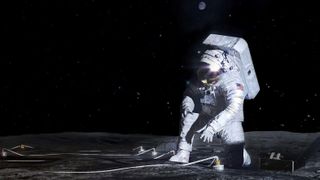
The first astronauts to land on the moon in more than half a century will set up a lunar mini-greenhouse, if all goes according to plan.
NASA has selected the first three science experiments to be deployed by astronauts on the moon's surface on the Artemis 3 mission in 2026. Among them is LEAF ("Lunar Effects on Agricultural Flora"), which will study how space crops fare in the exotic lunar environment.
"LEAF will be the first experiment to observe plant photosynthesis, growth and systemic stress responses in space-radiation and partial gravity," NASA officials wrote in a statement Tuesday (March 26) announcing the selection of the three experiments.
"Plant growth and development data, along with environmental parameters measured by LEAF, will help scientists understand the use of plants grown on the moon for both human nutrition and life support on the moon and beyond," they added.
The LEAF subjects won't be the first-ever flora on the moon; China sent cotton plants to the lunar far side on its robotic Chang'e 4 mission in January 2019.
Related: NASA's Artemis program: Everything you need to know
The other two newly selected experiments are the Lunar Environment Monitoring Station (LEMS) and the Lunar Dielectric Analyzer (LDA).
Get the Space.com Newsletter
Breaking space news, the latest updates on rocket launches, skywatching events and more!
LEMS is a suite of autonomous seismometers that will hunt for moonquakes for up to two years after deployment. It "will characterize the regional structure of the moon's crust and mantle, which will add valuable information to lunar formation and evolution models," NASA officials wrote in Tuesday's statement.
LDA, meanwhile, will measure the ability of lunar regolith — the moon's top layer of dust and gravel — to propagate an electric field. The instrument "will gather essential information about the structure of the moon's subsurface, monitor dielectric changes caused by the changing angle of the sun as the moon rotates and look for possible frost formation or ice deposits," agency officials wrote.
The instruments will be deployed near the moon's south pole, a region thought to be rich in water ice that could support one or more crewed outposts. The exact location is not yet known; NASA has not announced a final landing site for the Artemis 3 mission, which will use SpaceX's Starship vehicle to get astronauts from lunar orbit down to the surface and back again. (They'll get to lunar orbit via the agency's Space Launch System rocket and Orion capsule.)
And there's no guarantee that LEAF, LEMS and LDA will fly on Artemis 3. That's the current plan, but "final manifesting decisions about the mission will be determined at a later date," NASA officials wrote in Tuesday's update.
The Artemis 3 crew has not yet been announced, though NASA has said the mission will land a woman and a person of color on the moon for the first time ever.
Artemis 3 will be the first crewed mission to the lunar surface since Apollo 17 in December 1972. Artemis 3's predecessor, Artemis 2, will send four astronauts around the moon and back to Earth in late 2025, if all goes according to plan.
The month-long Artemis 1, a successful uncrewed mission to lunar orbit and back, launched in November 2022.
Join our Space Forums to keep talking space on the latest missions, night sky and more! And if you have a news tip, correction or comment, let us know at: community@space.com.

Michael Wall is a Senior Space Writer with Space.com and joined the team in 2010. He primarily covers exoplanets, spaceflight and military space, but has been known to dabble in the space art beat. His book about the search for alien life, "Out There," was published on Nov. 13, 2018. Before becoming a science writer, Michael worked as a herpetologist and wildlife biologist. He has a Ph.D. in evolutionary biology from the University of Sydney, Australia, a bachelor's degree from the University of Arizona, and a graduate certificate in science writing from the University of California, Santa Cruz. To find out what his latest project is, you can follow Michael on Twitter.
-
jan.wolitzky Care to stand behind your reporting? I'm willing to bet that Artemis astronauts will NOT carry plants to the moon in 2026, because Artemis 3 (or, at least, its lander) won't be ready to fly by then. Even the Government Accountability Office says so.Reply
